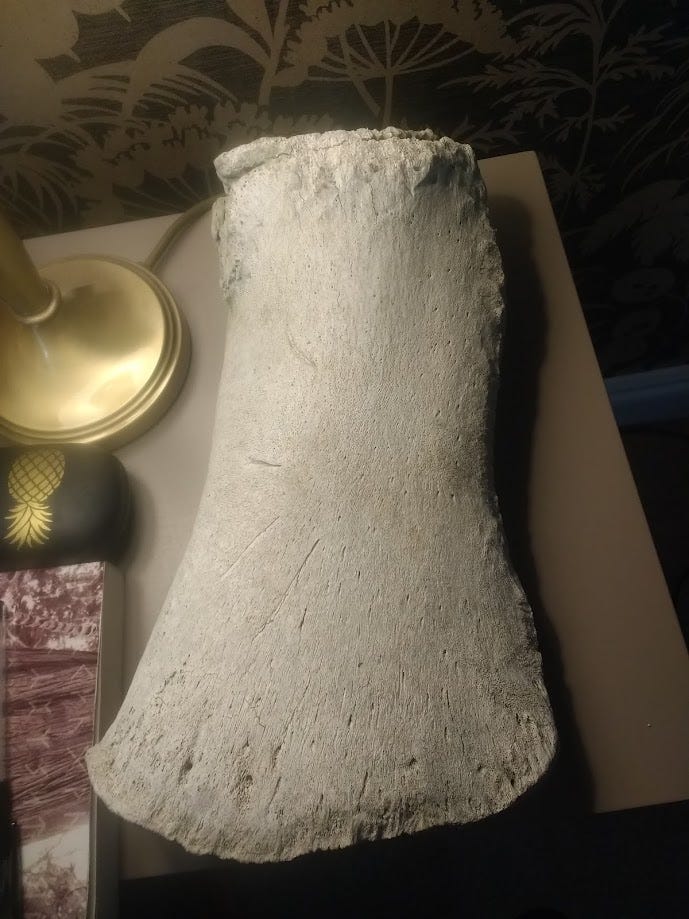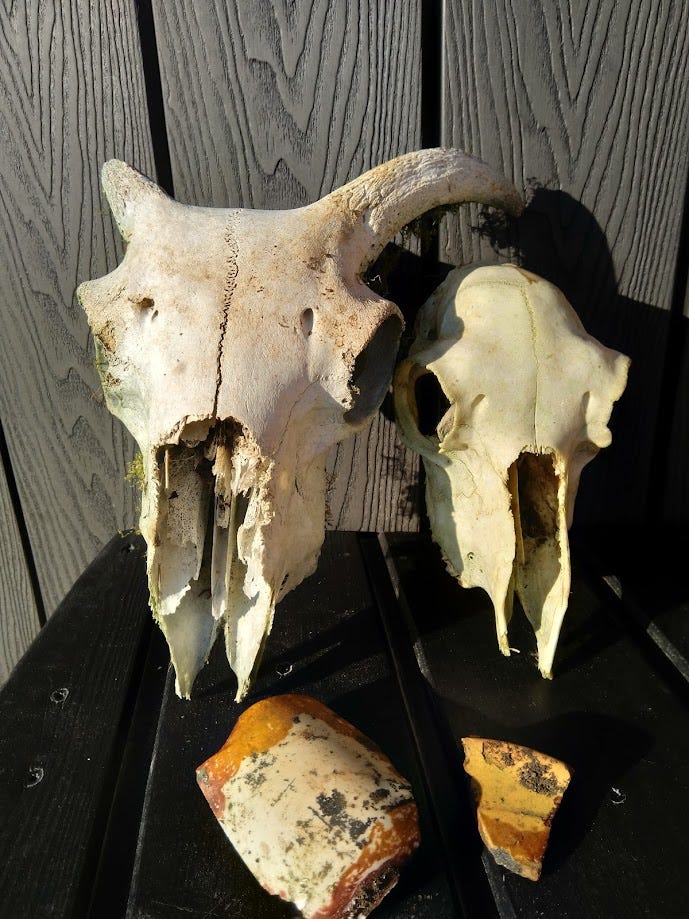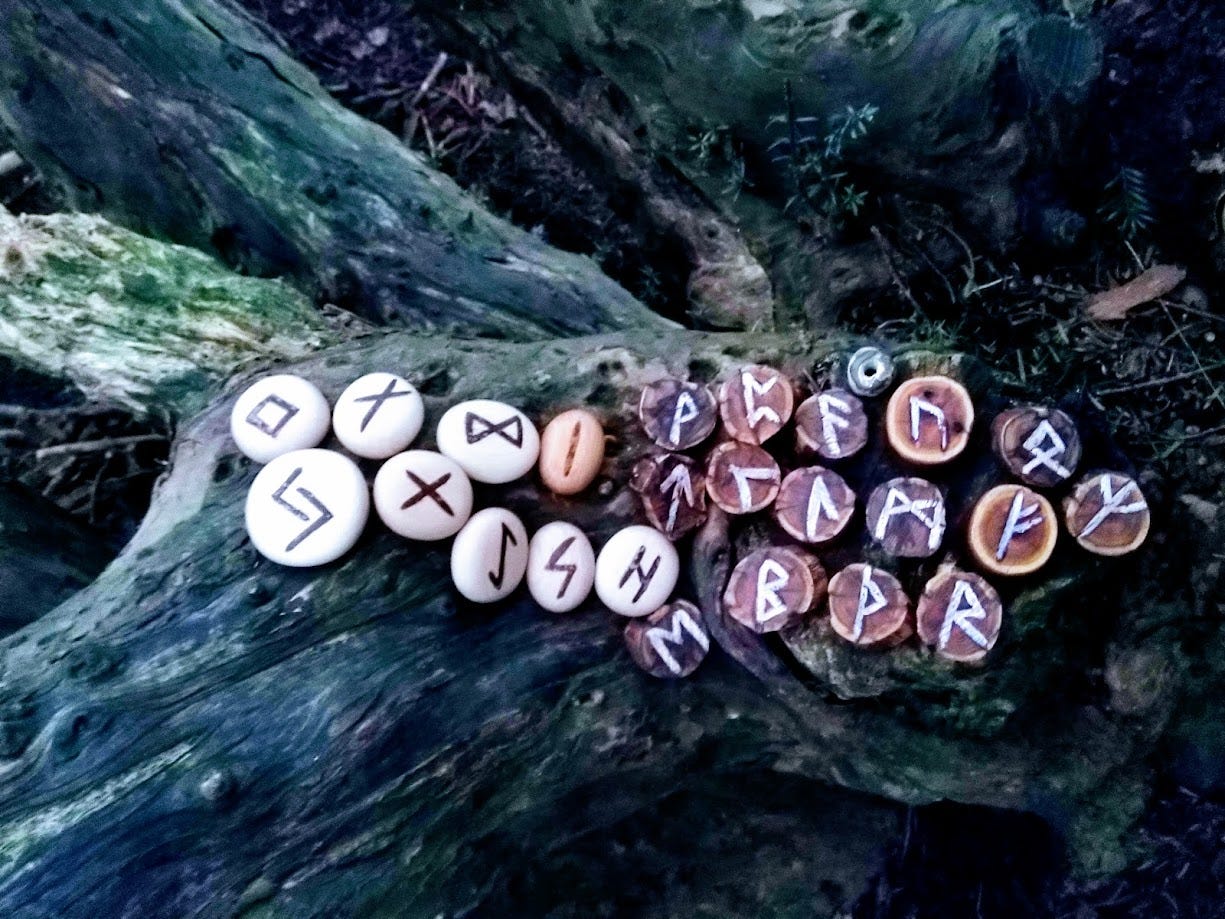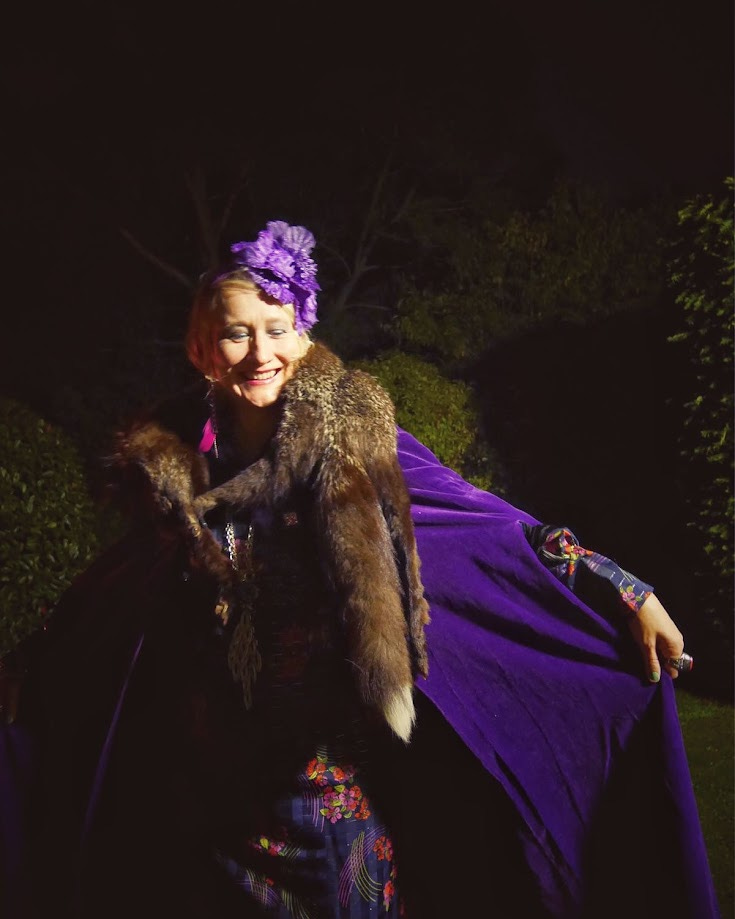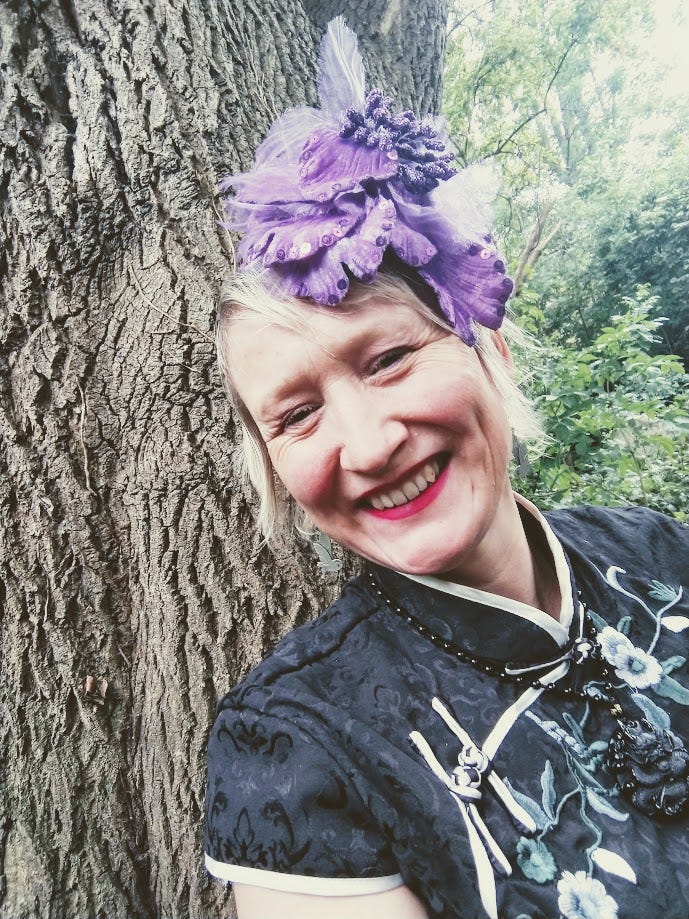As I traverse a current phase of grief, loss, reflection, and a shedding of skins, I revisit this essay I wrote and performed with Advantages of Ages at the wonderfully gothic Abney Cemetry, North London in 2019 as part of the Stoke Newington Literary Festival. My ceremonial and doula /psychopomp practice has since developed further, and next year I am aiming to complete my End-of-Life Doula diploma that I had to pause for a couple of years. Thank you again to Rose Rouse and Suzanne Noble who have been a steady support for my creative work. You can follow their Substacks along with AoA from my recommendations.
I’m a skeleton collector. I have a large sea-washed radius from a sperm whale beached on the sands in Orkney. Part of its flipper, its hand. One of my most treasured possessions is an early Victorian piece of scrimshaw, engraved with portraits of two women – the whaler’s wife and daughter or his lovers in different ports – made from a sperm whale’s tooth which I inherited from my father. I have a whole collection of teeth, ranging from a 50,000-year-old European cave bear’s molar to all my baby milk teeth kept by my mother alongside my four adult wisdom teeth taken out when I was aged 21. I can now keep my wisdom in my pocket.
Bones and teeth survive. Bones remind us of the transformation that occurs at death. I have a bunch of my hair too, a fist full of matted dreadlock strands woven with strips of fabric and beads, remnants of my brief ‘grunge’ phase in 1991 – hair which has lasted over 30 years. Like bones, hair lives on. I’ve come to understand I’m a bone worker. Bones have worked their way into my ‘medicine basket’ of ritual tools that have helped me navigate a year filled with death. From the sudden death of my mother at the end of 2017 to the sudden death of my mother-in-law within two weeks of that anniversary in December 2018, to the sudden death of a yoga friend who tragically took her own life shortly after this New Year. Their bones now are ash; only fragments of bone remain, returned to the earth to sit with ancestral bones or waiting, resting, keeping family company whilst loved ones adjust to the massive, unexpected earthquake of transformation that’s hit them. The dead must adjust too. Sometimes their souls need help crossing the mythic river in the Underworld. There lies the role of the shaman, the psychopomp, the death doula, the soul midwife, the priest, or priestess and the Irish mna caointe and baen-shea in the end-of-life and soul-crossing rituals they perform.
Through all of this, more than ever before, I’ve come to understand the value of ritual in our natural cycle of life and death. Ritual makes us human. Ritual connects us to our animal, secular and spiritual selves. We know many species have ritualistic behaviours. Corvids have been observed participating in mourning rituals, and I still have the vivid picture in my mind of a London raven jumping up and down on a dead bird’s body, cawing as if were singing an intense keening in St James’s Park as I walked to work. We now know that ritual increases the likelihood of species survival as it binds groups together. I wonder if this large, black bird was performing a ritualistic death dance to warn the rest of the flock, or was it in mourning? Ravens have long since been associated with death in folklore and myth.
Part of being human is coming to terms with death. Ritual has its place in helping us negotiate that final transformation – from ashes to ashes, dust to dust. In our increasingly secular society long focused on prizing youth above elderhood, and spending vast amounts of money on maintaining a youthful veneer, we have developed an unhealthy relationship with death. Death and its rituals have been pushed to the sidelines in this relentless pursuit of youth, of living as long as possible, even if the quality of that life is often questionable. Death has been taken out of the home and medicalised. So many people want to deny death, they fear death; by doing so death has gone underground until it rears its inevitable skeleton head.
Death is all around us, there is no escaping; delaying possibly, but let’s face it, it’s not going away. The planet is at the precipice of the sixth mass extinction, yet so many of us are ill-equipped for death. We’ve forgotten how to greet it, to sit with it, and ultimately how to mourn and grieve. However, many of us instinctively know that ritual has its place when it comes to death. Even if that instinct is sometimes more unconscious than conscious.
Death Demands Ritual
Death demands ritual. Not just the physical death of our loved ones: our partners, our elders, our families, our friends, our babies, our children, leading to our own death, but other symbolic deaths too. The end of our bleeding (if we’re a woman), our marriages, our jobs, our old, worn-out selves, all these transformations involve a final goodbye which deserves to be marked and mourned. Rituals and ceremonies can provide a framework to do just that. Underlying all ritual (and myth) is a universal pattern: the death and rebirth of a god or divinity that ensures the fertility of the land as well as social order and harmony. When we place ourselves at the heart of ritual we connect back into that universal pattern. I think that’s the key to ritual unlocking whatever transformation and change we are marking, honouring, letting go of or celebrating.
You don’t have to be religious to create a ritual. As I’ve discovered, consciously creating your rituals can be very cathartic and freeing. There can often be a sense of drama to ritual, and there is the idea that theatre itself emerged out of ritual. The performer in me, having created improvised theatre and dance over many decades, has been naturally drawn to creating rituals in recent years, particularly in this year of major loss. The death of the mother is one of the most fundamental deaths to grieve, since not only do we come into the world from our mothers, but they represent the fertility of our land, our society, and our ancestors. No wonder 2017/2018 was an earthquake year when I lost both my mother and my mother-in-law, within almost exactly a year of each other. At the same time, I had been losing my periods – the ultimate ending of my fertility, although an ending I was finally glad to embrace after giving birth to death through stillbirth and miscarriage. It took me 13 years, and many deaths in between to reach this place of acceptance.
Spirituality
Through all of these griefs, I’ve found myself creating rituals. I’m deeply spiritual but walk my own path. I’m equally at home in an old Anglo Saxon church service with a good soulful, non-judgemental vicar, as I am in a Buddhist ceremony with my given Tibetan ( Vajrayana or tantric) Buddhist name received in Java from a Tibetan monk – Munindra Sari [excellent or chief sage], or attending a Norse wisdom Heathen High Seat ceremony , but I am most definitely deeply spiritual. For many years, especially in my teens and then again in early 30s, I rejected the dogma and ingrained patriarchy of most monotheistic organised religions. The Bible had never really inspired me, outside of Sunday School, perhaps because it had been read aloud so boringly in church. For a very long time I just couldn’t relate to Jesus, and as a mythologist, I couldn’t understand how many people believed the Bible as gospel truth, not as a loose collection of allegorical stories written down many hundreds of years after the threads of various historical events had been spun through an oral tradition. However, I enjoyed the storytelling aspect at Sunday School and at age 14 easily gained an A grade in my compulsory O-level Religious Education. I guess it’s because I’m a storyteller.
In recent years though, I have re-connected with the divine feminine and masculine energies of Mary Magdelene and Yeshua, and their teachings of the heart. The Gnostic Gospels make sense to me and contain so much esoteric wisdom.
Craving ritual
When my baby died, I found myself craving ritual. I remember going into churches just to create my rituals focused on the Virgin Mary, lighting candles for her and my son. The archetypal mother who had also lost a son. To me, she was the only remnant of an ancient fertility goddess left, sanitised into a virgin by a male-dominated institution. I have found Catholic or High Church of England churches are always good for some goddess veneration in the form of Mary or our Lady of Guadalupe.
Their churches do the best smells and bells – because they understand the theatre of ritual. The three core aspects of ritual are:
1. blood sacrifice (the blood of Christ in a cup)
2. a natural process or mythic historical narrative (the Christian mythology), and
3. an act of magic (the Christian symbol of transformation, the Holy Communion)
Thirteen years on from that earthquake birth, I’m exploring and creating my rituals which have been particularly helpful during my year of mother's grief. I have organically gathered my ‘medicine’ basket with my tools of ritual. My bones, my incense, my core oracles – the runes and the roses – and various other objects of meaning and personal importance. My horse skin drum ‘Paskadi’, my rattle, my cloak, my hood, and my 1940s fox fur cape. The elements of ritualistic transformation. I’ve invited others to join my rituals and offer rune and rose reading rituals.
I created my rune set after being called to work with the runes in three dreams within three months of my mother’s death. This became a ritual in itself:
1. collecting the yew wood to complete the set. (I’d been given the first nine birch wood by Andreas Kornevall in my very first rune workshop at the College of Psychic Studies),
2. carving, sanding, polishing them
3. anointing them with the last vestiges of my own menstrual blood (the blood sacrifice), and sacred oils
4. to turn them into a tool that can help others transform (the magic),
5. underpinned with the Norse mythological framework (the narrative).
By working intuitively and instinctively, I’ve found that creating rituals both personal and shared, has helped me through my grief. It’s provided a focus and an outlet for my grief. When my mother was close to death (she died 24 hours after having a major stroke whilst out shopping), I somehow knew what to do. I didn’t consult a book; I wasn’t a member of a church, but I knew that ritual was important. In the year that’s passed, I’ve also discovered I have a natural ability to do what I now know as soul journey work. I’ve found I have ‘psychopomp’ abilities – I had to look this up – after experiencing very strong and vivid dreams and vision journeys with drumming, where I’ve helped dead or dying people (and trees) ‘cross over’ to the other side.
Birds as psychopomps
Let’s return to the corvids. Birds too, are said in many cultures to have a psychopomp nature, carrying the dead to the afterlife. A few days before I lost my son, I was lying in my old bedroom at my mother’s house, clinging on for dear life looking out at the sycamore tree at an unusual gathering of at least 15 magpies in the tree. There had not been one before or since. My mother and I were both struck by the strange occurrence. The magpie is my death bird and my magician. I don’t try to explain this psychopomp phenomenon, as ultimately I don’t think it matters. I simply accept it. All I know is the role of the psychopomp is known in myth, in folklore and ancient spiritual practices, down through the millennia. I’ve also started exploring the power of singing laments and keening from the Celtic Scottish and Irish traditions – coming as I do from strong Celtic and Gaelic stock as well as Norman Viking – using my drum to access these songs as they emerge. They are a powerful way to bring voice to death and grief.
There is a place for all this work – as we enter into a new, more open and frank relationship with death. Death is coming out of the shadows. Ritual most definitely has their place and new death rituals are emerging, rooted in our landscape, in a way that is meaningful for us today. The growth of the Death Cafe is one example of communities coming together to talk about death and break some of the taboos that have grown up in our youth-obsessed world. I went to one in Plymouth the week before I led a small family ceremony to bury my mother’s ashes in her family grave. The cafe was well-facilitated, we all sat around tables talking about our experiences of death, dying and grieving, and it was very light-hearted. There was much more laughter than I expected. Ultimately, I think that’s the trick – to laugh with death, even amid the tears, the anger and the whole gamut of emotions death wrings out of us. Gallows humour; morbid humour is there for a reason. Death doesn’t want us to be deathly serious…all the time.
So I’ll continue to collect my bones, read my runes and bang my drum whilst I lug my increasingly heavy medicine basket around the country singing to the land and telling stories to birds in the trees, laughing along the way like some crazy Sacred Fool dancing with Death. And strangely as I sit here in my mother's easy chair finishing this article, the voice on a radio play I’m listening to drifts over and says: “She deserves a good death.”
Resources and further reading
Chi In – my poem about death and the Sacred Fool
Francis Weller: The Wilder Edge of Sorrow also available on Spotify Premium as an audiobook
To book a rune and rose reading, a co-created ceremonial ritual for any occasion, poetry performance, oral storytelling and guest lectures do get in touch. I can do online and in-person events. Please visit www.runesnroses.com for a booking form or message me here.
For more on ritual, the book Ritual – A Very Short Introduction – by Barry Stephenson




